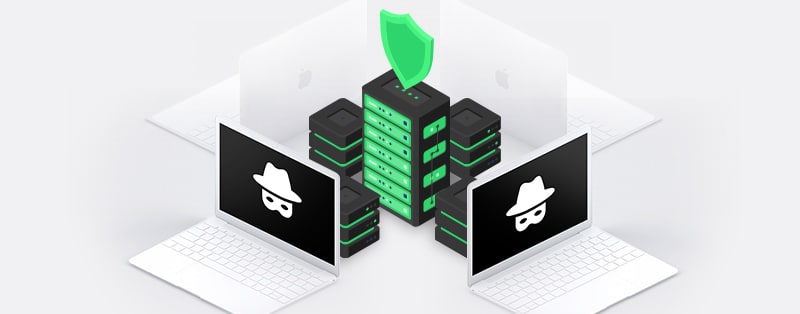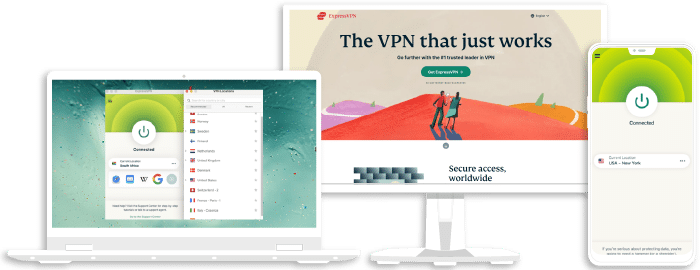What Is The Dark Web and How To Access It Safely

The internet is a vast digital space with so much information that you can’t go through all it has in a lifetime! Even if you decide to start canvassing through all the data online, you’ll never see the end because more data is uploaded to the web daily.
What’s even more fascinating is that parts of the web are not easily accessible to the general public and require special tools to access. It’s like exploring space (well, not as expensive, though).
The part of the internet the average user accesses daily is a small part of a vast network. There are hidden websites and services that make up the dark web, and if you decide to explore that deep, you must do so safely.
This article will show you the best way to explore the dark web without exposing yourself to your Internet Service Provider (ISP), the government, and other risks.
What Is The Dark Web?
Well, the dark web is a relatively hidden section of the internet that only a fraction of the world’s population has access to. It is buried beneath the surface web and deep web. To help you understand clearer, let’s quickly discuss each level of the internet:#
The Surface Web
The surface web, or clean web, is the regular side of the internet with websites you access through browsers like Google Chrome, Mozilla Firefox, and Safari. It is here you find your news pages, streaming and shopping platforms, and even this page you’re currently reading. Also, you can find content on the surface web through a simple Google search.
The surface web is monitored and managed by different web hosts, server administrators, ISPs, and governments. Although there seem to be countless amounts of data on the surface web, it only takes up a small portion of the entire internet, and your access is limited.
The Deep Web
Just under the surface lies the deep web. It is a part of the internet that has been cordoned off (with passwords in some cases) for particular purposes. The deep web takes up over 80% of the internet and is only accessible through specific links or login information.
The deep web comprises medical records, government databases, cloud drives, financial records, legal documents, company files, and other sensitive information. It is very common to confuse the deep web with the dark web, but they are very different.
The Dark Web
The dark web is the deepest layer of the internet and the hardest to access. Things operate very differently on this side of the internet. For starters, websites don’t use the same URL structure as surface and deep websites. Rather than the usual ‘www.abcxyz.com’ style, links on the dark web are made of random letters and numbers and end with .onion.
The dark web wouldn’t have the reputation it has if it were easy to access. Without a unique browser like Tor (The Onion Router), it would be impossible to access .onion websites on the dark web. Tor is the most popular choice, but there are other networks such as Freenet, Riffle, and I2P.
There’s no form of regulation on the dark web, so it is filled with tons of websites and services that are both legal and illegal. The nature of the dark web has been a cause of several controversies because you could purchase drugs, guns, malware, spyware, ransomware, or even hire an assassin through some channels on the dark web.
Although the Tor browser provides anonymity and some level of security, there’s a lot of cybercriminals that could easily target and attack you. Also, your ISP will be able to monitor your traffic and see when you access the Tor browser.
It would be best if you protect yourself before trying to access the dark web. We’ll be discussing how in more detail shortly.
How To Access the Dark Web Safely
As we’ve mentioned, the dark web is closely linked with nefarious activities, but it can also serve for good. For example, in situations of internet restrictions, government oppression, or surveillance, you can use the dark web to exercise your freedom of speech and internet access, protest against bad governance, or browse anonymously.
Regardless of your reason for accessing the dark web, your safety should be your primary concern. It is not the same as the regular internet space. Here’s a guide you can follow to access and surf the dark web safely:
1. Download and Install a VPN
First off, you should use a VPN (Virtual Private Network). This assures you of enhanced security and privacy. A VPN creates a secure “tunnel” to route your data traffic. It is designed to hide your actual IP address and give you another one from its VPN servers. Connecting to a VPN server also changes your location online. So, your ISP or any third party won’t be able to know your real identity or location.
Additionally, a VPN uses encryption to protect your browser traffic surveillance or falling into the wrong hands. It also uses various protocols and features to guarantee your privacy and security.
You can download a VPN from a VPN provider’s website or app stores (avoid downloading software from third-party sites). These apps are available across multiple operating platforms. There are many VPN providers on the market, but you should only settle for the best. We’ll discuss our top recommendation after this.
2. Download and Install the Tor browser
For safety, go to the official Tor website to download an installation file. Tor offers applications for Windows, macOS, iOS, Android, and Linux devices, so you have to click on your device logo and follow the installation prompts (this varies across devices).
3. Connect to a VPN Server
Before accessing the dark web through the Tor Browser, you need to connect to a VPN server. This gives you the anonymity and protection necessary for the dark web. The best VPN providers have expansive server networks spread across multiple regions in the world. This makes it easy for you to bypass censorship and restrictions.
You can connect to an available location you already have in mind or let the VPN randomly choose one for you. However, connecting to a nearby server guarantees faster and reliable connections.
For safety, you can test to see if your VPN connection is solid by conducting an IP leak test on sites like IPleak.net or whatismyipaddress.com. If any of these sites reveal your ISP IP address or your actual location, you’ll have to review your VPN connection.
4. Take Safety Precautions
Before you begin using the Tor browser, you need to observe some other safety measures such as closing unimportant applications, covering your webcam, installing a solid antivirus and anti-malware, and turning off your location on your device.
5. Launch the Tor Browser
With your VPN connection in place, you can now return to the Tor Browser. When you launch the app, you will have the option to “Connect” or “Configure.” If you’re in a location that restricts Tor, such as China, Egypt, and Turkey, or you’re connecting from a private network that needs a proxy, click on “Configure.” This helps you configure a pluggable transport. However, if you are not faced with such restrictions, you can click on “Connect” to start using Tor immediately.
6. Set the Security Level and Disable Scripts in the Tor Browser
For extra security, you can configure Tor’s security level to ‘Standard,’ ‘Safer,’ or ‘Safest.’ Safest is the highest level of security. Still, the drawback with this is that it causes you to experience really slow internet speeds, and some .onion sites won’t function properly. In addition, “safer” and “safest” disable scripts, most video, and audio formats, some images may not be displayed as they should, and other issues.
You can change Tor’s security level in these short steps:
- Open the Tor Browser
- Next, click on the shield icon in the upper right corner of the browser.
- Click on “Advanced Security Settings.”
- Locate the “Security” option
- Select “Safer” or “Safest” (Depending on what you prefer)
However, you should know that you can also turn off scripts without changing the Tor browser’s safety level. You can do this through these short and easy steps:
- First, enter this address into your Tor browser: “about:config.”
- Click on “I accept the risk.” Don’t be scared. It’s just standard procedure.
- Double click this text.
- Check to see if “value” now reads “falls” and “status” is on “modified.” If it does, the process was successful.
- Next, type the following into the search bar exactly as it is: “xpinstall.signatures.required”.
7. Visit Dark Web Websites
With your VPN, Tor, and other security measures in place, you can now safely surf the dark web.
Best VPN To Access the Dark Web Safely
There are many VPN providers currently on the market. While they are all advertised as your best shot at privacy and internet security, that’s not always the case. VPNs typically function the same, but the best options have features that set them apart.
Also, it is best to avoid using free VPN services because they pose risks also. However, here’s our pick for the best VPN you can use to access the dark web safely:
ExpressVPN
Overall score: 9.8
- Super-fast servers
- AES 256-bit encryption
- Supports private protocol, Lightway
- Money-back guarantee
30-Day Money-Back Guarantee!
As far as dark web VPNs go, it doesn’t get better than ExpressVPN. This VPN has the best security standards, fast and reliable internet speeds, and other outstanding VPN features. The company is based in the British Virgin Islands, and it operates more than 3000 servers in 90+ countries. In addition, ExpressVPN maintains a strict no-log policy, so your dark web activities are truly private.
ExpressVPN is equipped with military-grade AES 256-bit encryption. It also has DNS/IP leak protection to ensure your data doesn’t fall into the wrong hands. Additionally, it uses Private DNS to route your dark web traffic to avoid DNS request exposure.
Furthermore, ExpressVPN has a kill switch that shuts down your internet connection if your VPN connection drops or disconnects. It also supports split tunneling, so you can configure only your Tor browser to use the VPN while traffic from your other activities is routed directly to the internet.
ExpressVPN is available for Android, iOS, macOS, Windows, and Linux devices. However, it is a paid service. With a single account, you can connect up to five devices simultaneously. ExpressVPN plans are pretty expensive, but they often offer special bonuses and discounts. Also, you can try the VPN risk-free, thanks to a 30-day money-back guarantee.
Exclusive offer for Techrobot readers: $6.67/month (Save 49% + 3 months free)
30-Day Money-Back Guarantee!
Conclusion
The dark web has its good and bad aspects, but one thing that’s for sure is that it’s dangerous. So, whatever you need to access the dark web for, you need to use a VPN alongside the Tor browser for enhanced security and privacy. ExpressVPN is the best VPN out there, so you shouldn’t settle for less. Your privacy and security are essential, especially when surfing the dark web.

